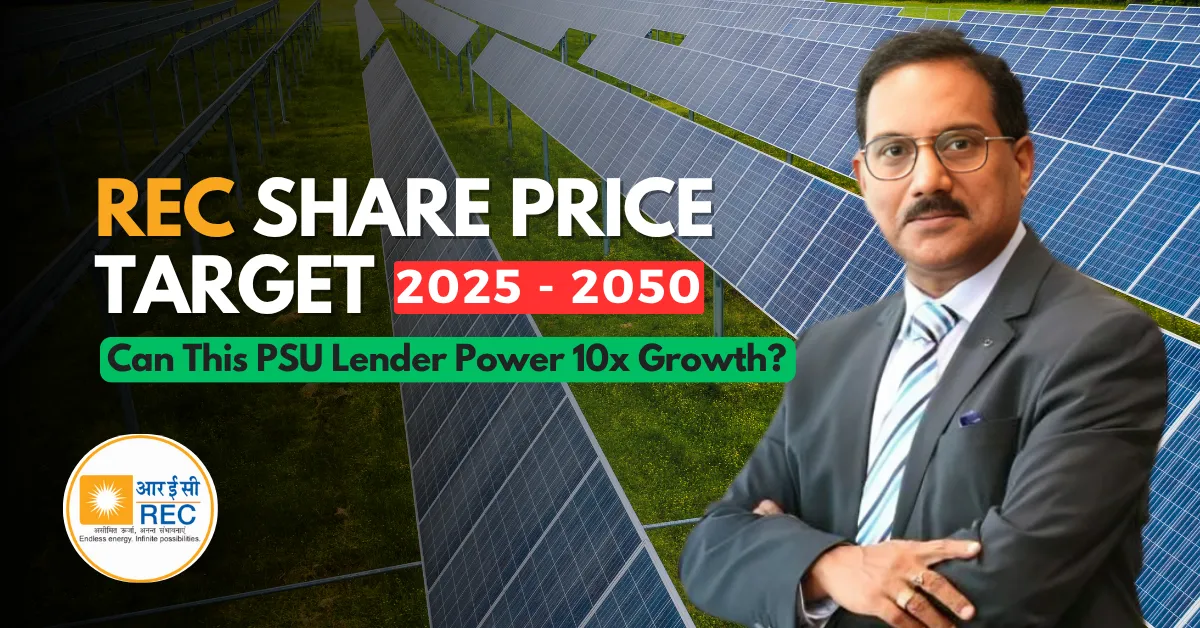REC Ltd (Rural Electrification Corporation), now a Maharatna PSU under Power Finance Corporation, is India’s powerhouse when it comes to financing the country’s electrification and energy infrastructure. With a strong dividend yield, a rapidly expanding renewable finance portfolio, and robust Q4 FY25 results, REC is gaining traction as a value pick for long-term investors.
In this article, we break down REC’s fundamentals, stock forecast till 2050, expert views, risks, and whether this PSU can truly multiply your portfolio value.
About the Company
- Founded: July 25, 1969
- Headquarters: New Delhi
- Parent Company: Power Finance Corporation (PFC)
- Operations: Financing electricity generation, transmission, distribution, and renewable energy projects like solar, wind, and EV infrastructure
REC plays a pivotal role in India’s green growth story by being the financial enabler for energy transition and rural electrification.
Q4 FY25 Financial Snapshot
- Total Income: ₹15,351.9 Cr (+22.4% YoY)
- Operating Profit: ₹5,540.7 Cr (+8.1%)
- PAT (Net Profit): ₹4,310 Cr (+5.7%)
- Operating Margin: ~36.1%
- EPS (Q4): ₹60.32
Annual Performance Metrics
- Dividend Yield: ~4.5% (Last payout ₹3.60/share)
- P/E Ratio: ~6.6x
- P/B Ratio: ~1.34x
- Dividend Payout Ratio: ~29.8%
- Net Loan Book: ₹5.67 Lakh Cr
- Renewable Lending Goal: ₹2.5 Lakh Cr by FY30 (~30–40% portfolio)
REC continues to impress with both profitability and aggressive lending targets toward India’s clean energy sector.

REC Ltd Share Price Forecast: 2025 to 2050
| Year | Min Target (₹) | Max Target (₹) |
|---|---|---|
| 2025 | 380 | 420 |
| 2026 | 420 | 450 |
| 2027 | 450 | 580 |
| 2028 | 510 | 615 |
| 2030 | 740 | 880 |
| 2035 | 1,050 | 1,350 |
| 2040 | 1,200 | 1,619 |
| 2045 | 1,800 | 2,500 |
| 2050 | 2,500 | 4,000 |
Targets after 2030 are modeled using compound growth assumptions based on loan book, renewable exposure, and historical P/E expansion.
Growth Drivers
- High Dividend Yield: Attractive ~4.5% payout attracts long-term capital
- Aggressive Renewable Lending Push: ₹2.5 Lakh Cr targeted by FY30
- Loan Book Strength: ₹5.67 Lakh Cr financing across thermal, transmission, and solar projects
- Strong Asset Quality: Improving margins and low NPAs
- Supportive Government Policies: Clean energy targets, green bond framework, and PSU reform tailwinds
REC is not just a PSU—it’s transforming into a green-financing engine.
Expert Opinions
- Motilal Oswal: Buy, Target ₹460
- Fintel: 1-year average target of ₹562.7
- WalletInvestor: ₹1,121.9 by 2030
- Analyst Consensus (13 Analysts): 100% Buy; Avg TP ₹533.9 (range: ₹460–₹700)
REC is increasingly viewed as undervalued by major analysts thanks to its dividend and green asset pivot.
Key Risks & Concerns
- Interest Coverage Pressure: Expanding loan book may increase leverage
- Execution on Renewables: Meeting ₹2.5 Lakh Cr target needs aggressive pipeline
- Macro & Fiscal Sensitivity: Linked to GDP, capex cycles, and rate cycles
- Undervaluation Trap: Market may continue discounting PSUs despite performance
These risks are manageable, but investors should stay updated on debt servicing ratios and execution timelines.
Investment Suitability
Best For:
- Dividend-focused investors (4–5% steady income)
- Long-term clean energy believers
- Value investors who spot potential early
Not For:
- Short-term momentum chasers
- Risk-averse investors avoiding NBFC/infra exposure
REC’s stability plus growth story makes it a strong contender in the PSU basket.
FAQs
Q1. Can REC reach ₹1,121 by 2030?
Yes. depends on forecasts that level based on earnings and asset growth.
Q2. Is REC’s dividend sustainable?
Absolutely. FY25 dividend was ₹3.60/share with a consistent 4–5% yield.
Q3. How much of REC’s book is renewable lending?
Currently ~10%; management plans to scale to 30–40% by FY30.
Q4. Is REC undervalued at current levels?
Yes—P/E of ~6.6x and strong PAT growth offer a margin of safety.
Q5. Will India’s energy push benefit REC?
Definitely. REC funds projects central to India’s clean energy roadmap.
Also Read: RVNL Share Price Target & Stock Forecast 2025 to 2050 – Will This Railway PSU Keep Compounding?
Conclusion
REC Ltd is building the financial backbone of India’s green infrastructure. With one of the highest PSU dividend yields, improving profitability, and renewable energy exposure, REC offers a powerful combo of income + growth. For investors with a long-term horizon till 2030–2050, REC has potential for 5–10× returns if execution continues.




